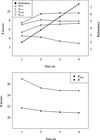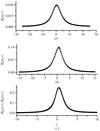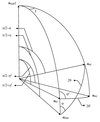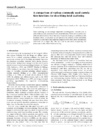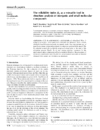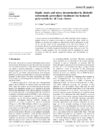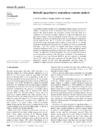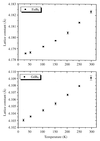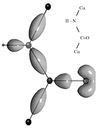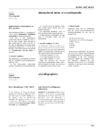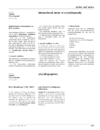issue contents
April 2001 issue

Cover illustration: Diffuse scattering around a 200 Bragg peak from a Cu-Ti single crystal (the intensities are in ln scale, the plane is (001), with the [100] direction horizontal, and the Bragg peak is masked by the blue beam stop). Courtesy of O. Lyon, C. Servant & J. P. Simon [J. Appl. Cryst. (2000), 33, 928-937].
research papers
Two complementary 6 × 4 matrix `clear strategy screens' have been developed and tested on a number of previously non-crystallized proteins. The screens yielded diffraction-quality crystals of a wide range of proteins (enzymes, transcription factors, structural proteins, etc.) in cases where the applications of commercially available screens were unsuccessful.
The thicknesses of cobalt coating layers grown on four different types of acicular Fe3O4 particles were estimated from the analysis of lattice images and from the determination of the Co depth profile using high-resolution transmission electron microscopy (HR-TEM) coupled with an EDX system. It was observed that the coating thickness might vary with the crystallite size resulting from the growth mechanism of the coating layer.
Diffuse scattering near the displacive order–disorder phase transition in titanite, CaTiOSiO4, has been observed using synchrotron radiation and it is interpreted in terms of a two-dimensional ordering of linearly correlated Ti displacements.
The Rietveld method has proved to be a very effective means to characterize and quantify the crystalline phases and the amorphous phase in glass ceramic materials using X-ray powder diffraction data. The technique was applied to a borosilicate glass of the type used for high-level nuclear-waste containment, in order to measure the proportions of the crystallized phases after heat treatment and, thus, to qualify the thermal stability of the glass.
Small- and ultra-small-angle neutron scattering (SANS, USANS) and small-angle X-ray scattering (SAXS) were employed to study the nature and agglomeration of H–vacancy complexes in the Al–H system. The SAXS results were ambiguous owing to double Bragg scattering, but the SANS and USANS investigation, coupled with results from inelastic neutron scattering, and transmission and scanning electron microscopy, revealed the existence of a large size distribution of hydrogen bubbles on the surface and in the bulk of the Al–H system.
Some global criteria that indicate the overall quality of diffraction data are presented. They are discussed and evaluated with respect to their performance in various crystallographic tasks.
Two power series expansions are obtained for two cases of asymmetric Voigt line shapes: a linear combination of the Voigt line shape (VLS) and its derivatives, valid for small asymmetries, and the sum of the VLS and an odd-parity line shape, valid for intermediate asymmetries. An improved line shape, defined as a linear combination of the traditional VLS with the odd-parity line shape, is also presented.
A formula of the instrumental function for a synchrotron X-ray diffractometer has been derived. The experimental profiles of standard Si powder are well reproduced by the model profile function given by the convolution of a Lorentzian function with the instrumental function, within experimental uncertainty.
The grazing-incidence X-ray scattering geometry is analysed with regard to the correction for refraction when the angle of incidence is slightly larger than the critical angle and considering the smearing of the recorded pattern depending on the size of the illuminated sample region.
Two-dimensional multiple-diffraction patterns calculated within the framework of the kinematical theory are compared with ω–ψ scans of silicon and diamond measured with synchrotron radiation.
The first chromatic hard X-ray interferometer with a large and variable path length difference has been built and successfully tested.
The formalism that describes total-scattering correlation functions is developed using a consistent notation and is compared with other, frequently encountered, formalisms. It is hoped that this will lead to increased transparency for newcomers to the field of total scattering.
Diffraction line shifts in Rietveld refinement are modeled via a series of generalized spherical harmonics. Strain and stress tensors can be determined through the refinement of strain-related coefficients simultaneously with other parameters.
Amorphous phases do not diffract coherently, but from the overestimation of an appropriate crystalline standard added to the sample, the amorphous content can be measured with an accuracy close to 1%.
cryocrystallography papers
Download citation


Download citation


The use of a noncrystalline perdeuterated cryoprotectant for neutron studies is evaluated in the context of solvent-containing molecular crystals.
short communications
By analysing the low-temperature X-ray patterns, it is found that the lattice constants of EuB6 and GdB6 decrease monotonously with decreasing temperature. The linear thermal expansion coefficients for the two compounds were also obtained by analysing the temperature dependence of the lattice constants.
computer programs
A description of the EXPGUI graphical user interface for the GSAS package is presented.
The program MOPRO has been developed for charge density analysis of macromolecules. The advantage of using restraints in the charge density analysis of both small and large molecules is discussed, and the algorithmic optimizations and the parallelization of the program are presented.
laboratory notes
A greasing device to facilitate the application of grease to a 24-well crystallization plate is presented.
international union of crystallography
Free 

crystallographers
Free 

Free 



 journal menu
journal menu













